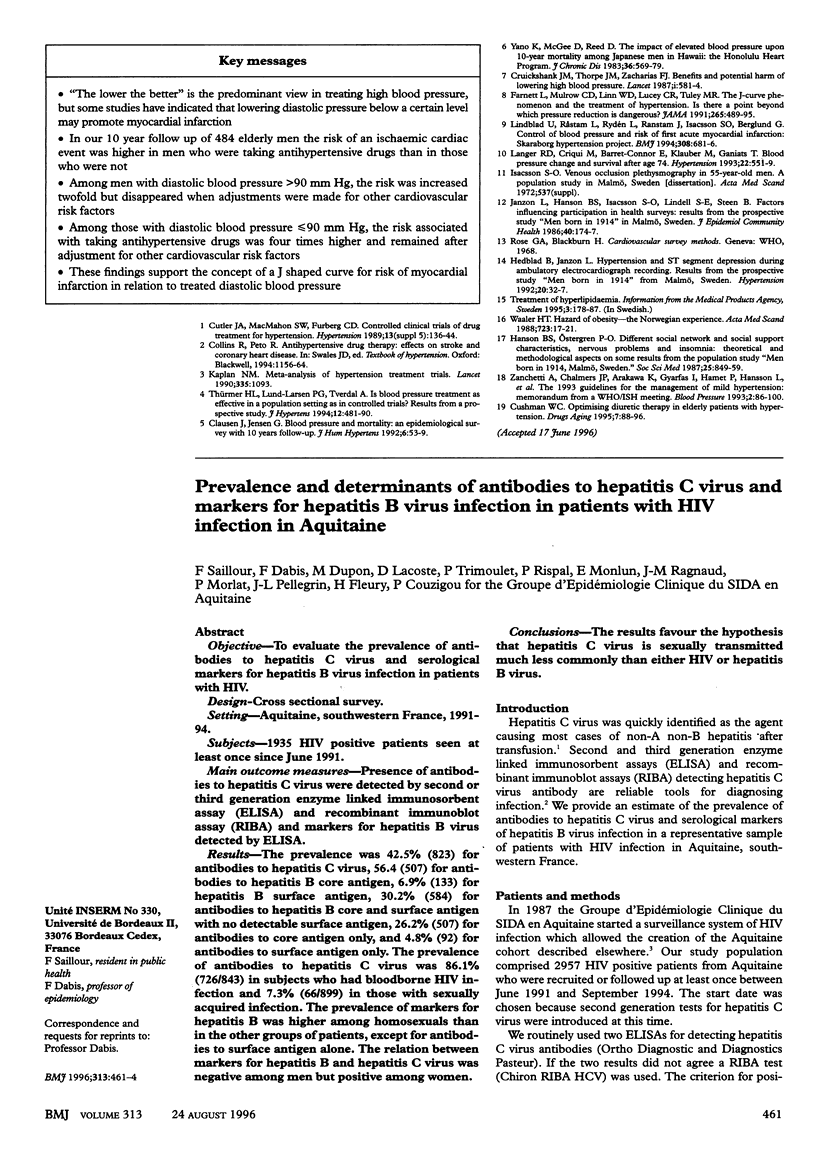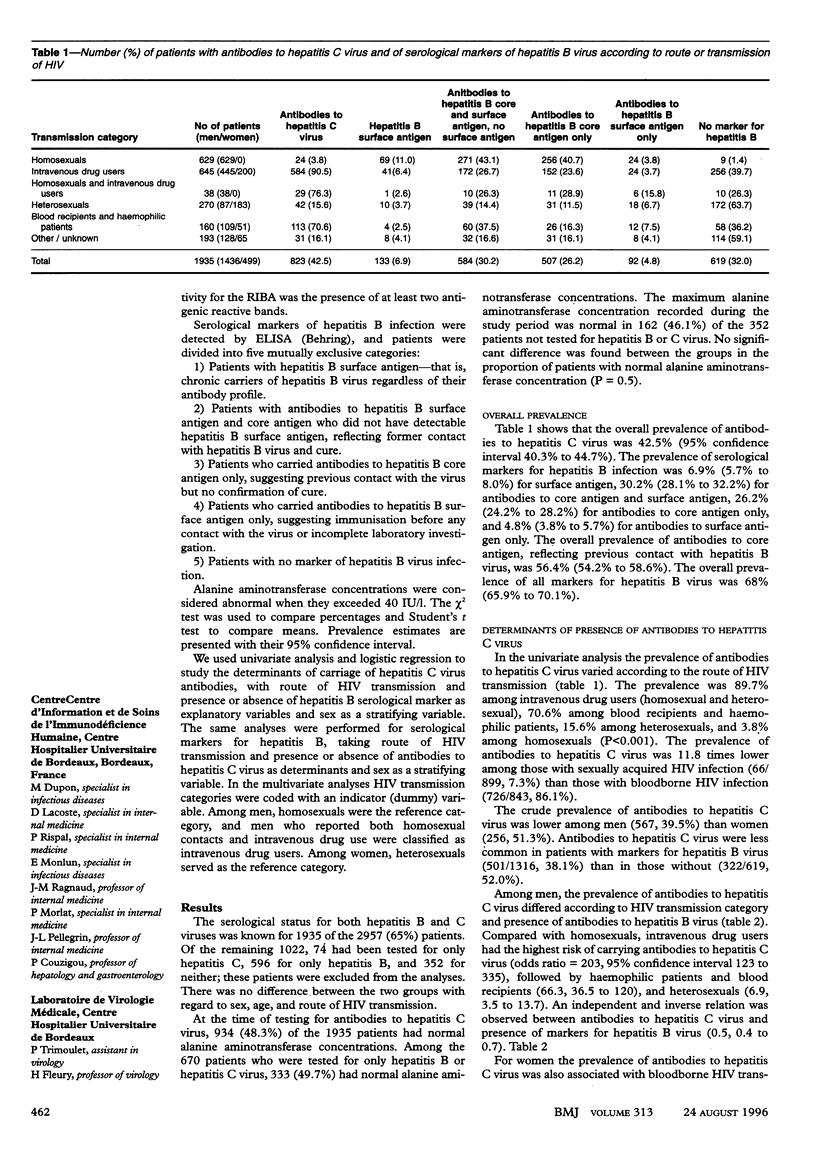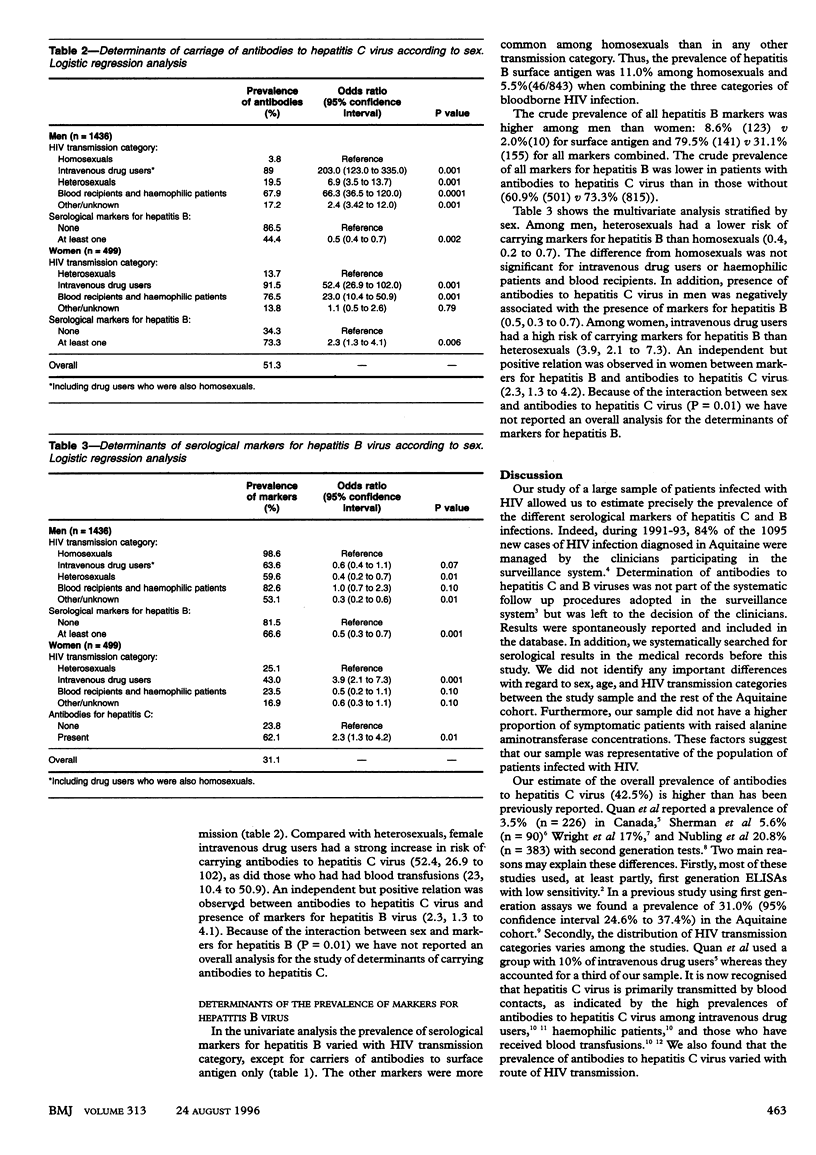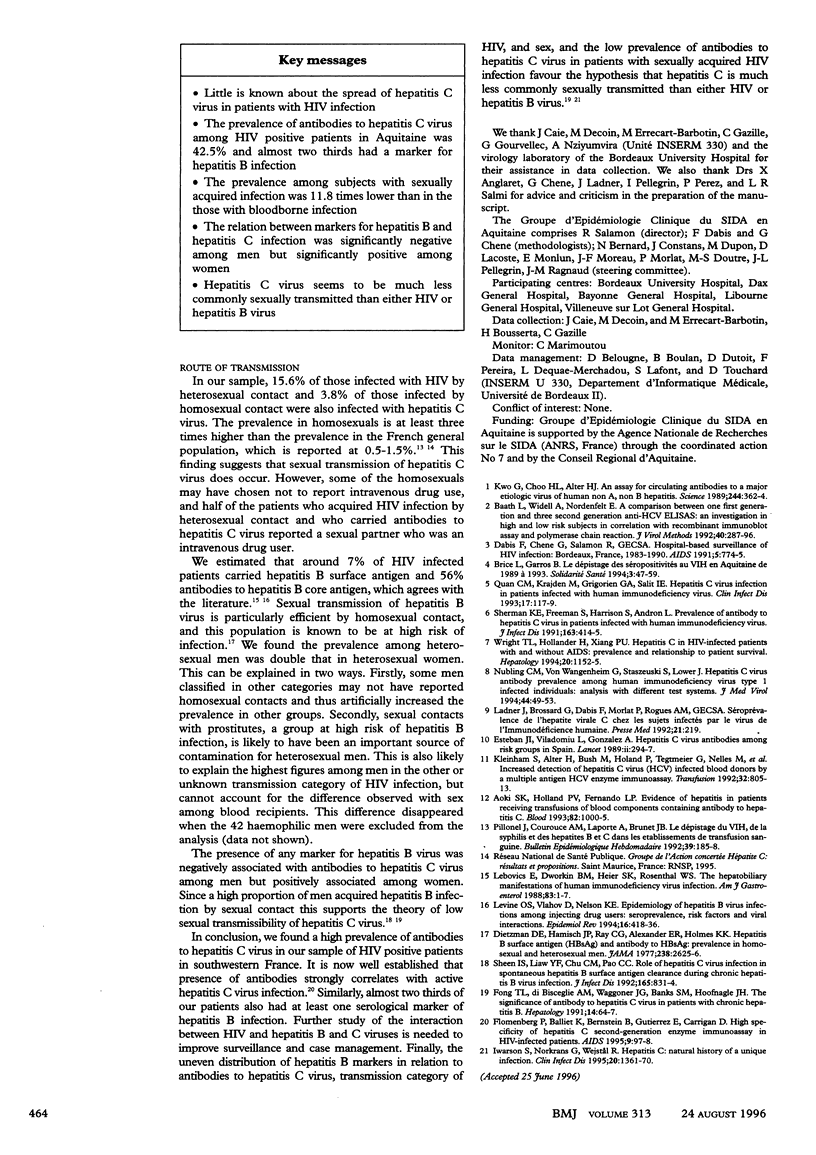Abstract
OBJECTIVE: To evaluate the prevalence of antibodies to hepatitis C virus and serological markers for hepatitis B virus infection in patients with HIV. DESIGN: Cross sectional survey. SETTING: Aquitaine, southwestern France, 1991-94. SUBJECTS: 1935 HIV positive patients seen at least once since June 1991. MAIN OUTCOME MEASURES: Presence of antibodies to hepatitis C virus were detected by second or third generation enzyme linked immunosorbent assay (ELISA) and recombinant immunoblot assay (RIBA) and markers for hepatitis B virus detected by ELISA. RESULTS: The prevalence was 42.5% (823) for antibodies to hepatitis C virus, 56.4 (507) for antibodies to hepatitis B core antigen, 6.9% (133) for hepatitis B surface antigen, 30.2% (584) for antibodies to hepatitis B core and surface antigen with no detectable surface antigen, 26.2% (507) for antibodies to core antigen only, and 4.8% (92) for antibodies to surface antigen only. The prevalence of antibodies to hepatitis C virus was 86.1% (726/843) in subjects who had bloodborne HIV infection and 7.3% (66/899) in those with sexually acquired infection. The prevalence of markers for hepatitis B was higher among homosexuals than in the other groups of patients, except for antibodies to surface antigen alone. The relation between markers for hepatitis B and hepatitis C virus was negative among men but positive among women. CONCLUSIONS: The results favour the hypothesis that hepatitis C virus is sexually transmitted much less commonly than either HIV or hepatitis B virus.
Full text
PDF



Selected References
These references are in PubMed. This may not be the complete list of references from this article.
- Aoki S. K., Holland P. V., Fernando L. P., Kuramoto I. K., Anderson S., Sazama K., Schoening V., Johnson P., Wilber J. C., Fenner L. Evidence of hepatitis in patients receiving transfusions of blood components containing antibody to hepatitis C. Blood. 1993 Aug 1;82(3):1000–1005. [PubMed] [Google Scholar]
- Båth L., Widell A., Nordenfelt E. A comparison between one first generation and three second generation anti-HCV ELISAs: an investigation in high- and low-risk subjects in correlation with recombinant immunoblot assay and polymerase chain reaction. J Virol Methods. 1992 Dec 1;40(3):287–296. doi: 10.1016/0166-0934(92)90087-t. [DOI] [PubMed] [Google Scholar]
- Cushing A. H. Diskitis in children. Clin Infect Dis. 1993 Jul;17(1):1–6. doi: 10.1093/clinids/17.1.1. [DOI] [PubMed] [Google Scholar]
- Dabis F., Chêne G., Salamon R., Msellati P., Etcheverry B. Hospital-based surveillance of HIV infection: Bordeaux, France, 1983-1990. Groupe d'Epidémiologie Clinique du SIDA en Aquitaine (GECSA) AIDS. 1991 Jun;5(6):774–775. [PubMed] [Google Scholar]
- Dietzman D. E., Harnisch J. P., Ray C. G., Alexander E. R., Holmes K. K. Hepatitis B surface antigen (HBsAg) and antibody to HBsAg. Prevalence in homosexual and heterosexual men. JAMA. 1977 Dec 12;238(24):2625–2626. [PubMed] [Google Scholar]
- Flomenberg P., Balliet K., Bernstein B., Gutierrez E., Carrigan D. High specificity of hepatitis C second-generation enzyme immunoassay in HIV-infected patients. J Acquir Immune Defic Syndr Hum Retrovirol. 1995 May 1;9(1):97–98. doi: 10.1097/00042560-199505010-00014. [DOI] [PubMed] [Google Scholar]
- Fong T. L., Di Bisceglie A. M., Waggoner J. G., Banks S. M., Hoofnagle J. H. The significance of antibody to hepatitis C virus in patients with chronic hepatitis B. Hepatology. 1991 Jul;14(1):64–67. doi: 10.1002/hep.1840140111. [DOI] [PubMed] [Google Scholar]
- Iwarson S., Norkrans G., Wejstål R. Hepatitis C: natural history of a unique infection. Clin Infect Dis. 1995 May;20(5):1361–1370. doi: 10.1093/clinids/20.5.1361. [DOI] [PubMed] [Google Scholar]
- Kleinman S., Alter H., Busch M., Holland P., Tegtmeier G., Nelles M., Lee S., Page E., Wilber J., Polito A. Increased detection of hepatitis C virus (HCV)-infected blood donors by a multiple-antigen HCV enzyme immunoassay. Transfusion. 1992 Nov-Dec;32(9):805–813. doi: 10.1046/j.1537-2995.1992.32993110750.x. [DOI] [PubMed] [Google Scholar]
- Kuo G., Choo Q. L., Alter H. J., Gitnick G. L., Redeker A. G., Purcell R. H., Miyamura T., Dienstag J. L., Alter M. J., Stevens C. E. An assay for circulating antibodies to a major etiologic virus of human non-A, non-B hepatitis. Science. 1989 Apr 21;244(4902):362–364. doi: 10.1126/science.2496467. [DOI] [PubMed] [Google Scholar]
- Ladner J., Brossard G., Dabis F., Morlat P., Rogues A. M. Séroprévalence de l'hépatite virale C chez les sujets infectés par le virus de l'immunodéficience humaine. Groupe d'Epidémiologie Clinique du SIDA en Aquitaine (GECSA). Presse Med. 1992 Feb 8;21(5):219–219. [PubMed] [Google Scholar]
- Lebovics E., Dworkin B. M., Heier S. K., Rosenthal W. S. The hepatobiliary manifestations of human immunodeficiency virus infection. Am J Gastroenterol. 1988 Jan;83(1):1–7. [PubMed] [Google Scholar]
- Levine O. S., Vlahov D., Nelson K. E. Epidemiology of hepatitis B virus infections among injecting drug users: seroprevalence, risk factors, and viral interactions. Epidemiol Rev. 1994;16(2):418–436. doi: 10.1093/oxfordjournals.epirev.a036161. [DOI] [PubMed] [Google Scholar]
- Sheen I. S., Liaw Y. F., Chu C. M., Pao C. C. Role of hepatitis C virus infection in spontaneous hepatitis B surface antigen clearance during chronic hepatitis B virus infection. J Infect Dis. 1992 May;165(5):831–834. doi: 10.1093/infdis/165.5.831. [DOI] [PubMed] [Google Scholar]
- Sherman K. E., Freeman S., Harrison S., Andron L. Prevalence of antibody to hepatitis C virus in patients infected with the human immunodeficiency virus. J Infect Dis. 1991 Feb;163(2):414–415. doi: 10.1093/infdis/163.2.414. [DOI] [PubMed] [Google Scholar]
- Wright T. L., Hollander H., Pu X., Held M. J., Lipson P., Quan S., Polito A., Thaler M. M., Bacchetti P., Scharschmidt B. F. Hepatitis C in HIV-infected patients with and without AIDS: prevalence and relationship to patient survival. Hepatology. 1994 Nov;20(5):1152–1155. [PubMed] [Google Scholar]


